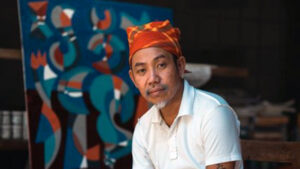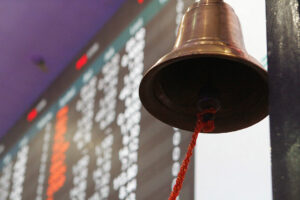By Brontë H. Lacsamana Reporter
AN ENTIRE gamut of emotions, scenes, and experiences can be drawn from the complex cultures of Mindanao.
For visual artist Kublai Millan, it takes decades of journeying and introspection around the vast island to sum it all up in abstract figures and colors.
“I feel like I’ve been in the industry for quite a while, doing my monuments, and I think I’m allowed to summarize because I’ve seen a lot and experienced a lot,” he told BusinessWorld.
At Art Lounge Manila at The Podium in Ortigas, Mr. Millan’s exhibit “Summa” highlighted works that bring out the summation of his philosophy as a Mindanaoan artist — from expansive triptychs that make up The Sun Above to colorful multitudes showing The Earth Below.
These canvases, seeming abstract and meandering in their effort to grasp a life in art, are chockfull of symbols that reflect Maranao, Tausug, and Manobo cultures.
Crescent moons and bulb-shaped minarets are accompanied by crosses and shields, while Moro-style okir lines ebb and flow to mimic flowers, ferns, stars, lizards, and fish.
“There’s a book on Mindanao patterns. If you’re into symbology, you’ll find I hide many geometric patterns in those works. But the rest are just flowing lines found in nature alongside the curly cues of Islamized art. It all short circuits,” Mr. Millan said.
Painting the story of his people is not his full-time job, however.
As Mindanao’s most prolific visual artist, Mr. Millan specializes in larger-than-life sculptures and monuments, of which he builds around 10 a year.
It all started in 2001, when he was denied a US visa for a tour that he had been arranging for months. This led him to depression and, eventually, the conviction to “never do another artwork again unless it’s bigger, heavier, and taller than the biggest, heaviest, tallest living American.”
“When I started, I felt I was born for it. And ever since I finished my first commission in 2002, I haven’t stopped. I build around 10 monuments a year all over Mindanao, reaching as high as 100 feet,” said Mr. Millan.
Some of his largest and most known works are the giant durian monument at the Davao International Airport, a 50-foot traditional kampilan or sword in Sultan Kudarat in Maguindanao province, and the Risen Christ in a church in Tagum City.
“I also make monuments for mass graves for Yolanda and tragedies like the war in Marawi. I don’t have time for private commissions, not even for money. I create monuments for cultural and historical purposes,” he said.
The abstracts in “Summa” are also not his first. Mr. Millan had done a few before but just never released them, since exhibiting paintings is an endeavor he’d do once a year compared to his many, frequent monuments.
“I only package and put all my thoughts together into a work of art which can sell, so that I can use my money for my advocacies,” he added.
Mr. Millan organizes mentoring programs that allow artists to immerse themselves in Mindanaoan culture, workshops that empower local tribes to paint their own stories, and the annual Mindanao Art Fair which puts local talent at the forefront.
“This is not my art,” he said, gesturing to the visually stunning Sum of Symbols behind him. “This is only a prelude to the real art in the communities. These are dead skin cells that I shred, but it’s not my art.”
Kublai Millan’s “Summa” exhibit at Art Lounge Manila at The Podium in Ortigas ended on July 15. It will run at the Art Lounge Manila at Molito Lifestyle Center in Alabang from Aug. 1 to Aug. 13.






